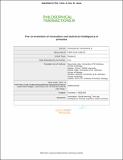The coevolution of innovation and technical intelligence in primates
Abstract
In birds and primates, the frequency of behavioural innovation has been shown to covary with absolute and relative brain size, leading to the suggestion that large brains allow animals to innovate, and/or that selection for innovativeness, together with social learning, may have driven brain enlargement. We examined the relationship between primate brain size and both technical (i.e. tool using) and non-technical innovation, deploying a combination of phylogenetically informed regression and exploratory causal graph analyses. Regression analyses revealed that absolute and relative brain size correlated positively with technical innovation, and exhibited consistently weaker, but still positive, relationships with non-technical innovation. These findings mirror similar results in birds. Our exploratory causal graph analyses suggested that technical innovation shares strong direct relationships with brain size, body size, social learning rate and social group size, whereas non-technical innovation did not exhibit a direct relationship with brain size. Nonetheless, non-technical innovation was linked to brain size indirectly via diet and life-history variables. Our findings support ‘technical intelligence’ hypotheses in linking technical innovation to encephalization in the restricted set of primate lineages where technical innovation has been reported. Our findings also provide support for a broad co-evolving complex of brain, behaviour, life-history, social and dietary variables, providing secondary support for social and ecological intelligence hypotheses. The ability to gain access to difficult-to-extract, but potentially nutrient-rich, resources through tool use may have conferred on some primates adaptive advantages, leading to selection for brain circuitry that underlies technical proficiency.
Citation
Navarrete Rodriguez , A F , Reader , S M , Street , S E , Whalen , A & Laland , K N 2016 , ' The coevolution of innovation and technical intelligence in primates ' , Proceedings of the Royal Society B: Biological Sciences , vol. 371 , no. 1690 , 20150186 . https://doi.org/10.1098/rstb.2015.0186
Publication
Proceedings of the Royal Society B: Biological Sciences
Status
Peer reviewed
ISSN
0962-8452Type
Journal article
Collections
Items in the St Andrews Research Repository are protected by copyright, with all rights reserved, unless otherwise indicated.

